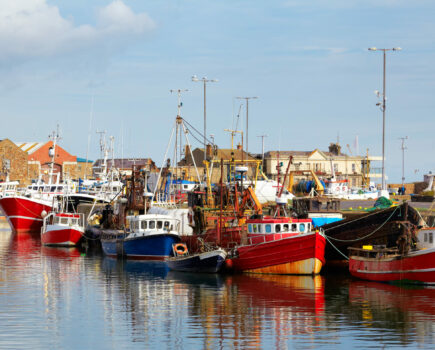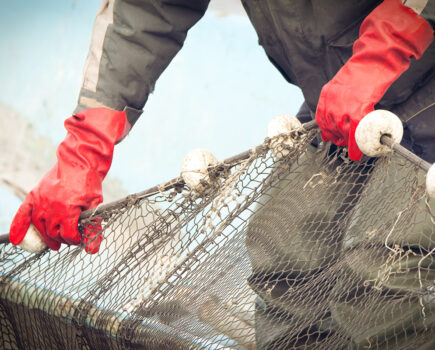A CEFAS scientist says returns from tagged bass show that bass migrate over even longer distances than was previously thought.
Dr Ewan Hunter, who is leading a four-year CEFAS bass-tagging project, said the return rate from the tagging experiments was ‘fantastic’.
“The information that comes in from the tags is jaw dropping,” he told Fishing News. “We always knew bass are mobile predators but the extent of their movement is surprising. They are crossing several management boundaries in a couple of seasons, and at any one time they are vulnerable to a whole variety of fishing gears.”
“We are really trying to clarify the movements of the fish, the problematic interactions between inshore and offshore fisheries, and the movements of individual fish between fisheries – the fish are swimming around laughing in the face of fisheries management.”
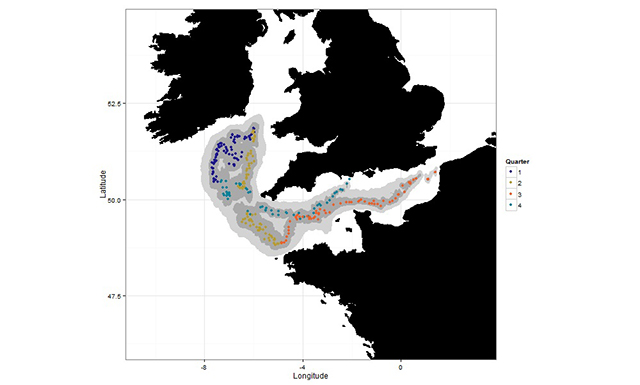
Track of tagged bass released at Weymouth and captured by a trawler off Dungeness after 300 days.
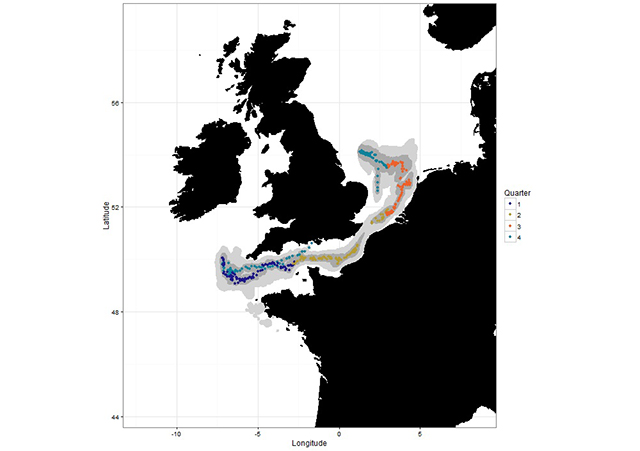
Track of the bass that spent the longest period between release and capture so far encountered from recovered tags – 383 days.
Dr Hunter said that the longer the period between the release of the fish and the return of a tag the better, because it gave a much fuller picture of the fish’s movements. The longest period so far was 383 days and that fish, one year after its release, had not returned to its Weymouth release site (see below and map for details of the fish’s movements).
“The tags that we get back this coming year will be the really important ones, that give us more than one dimension of fish movement,” he said.
“We all read that bass have a high fidelity to both their spawning grounds and feeding areas – we will be able to test that, to see whether fish are coming back to the same places at the same time of year, every year. Some of the fish returned so far certainly weren’t recaptured where they were located in the previous year.”
He said the tagging had already begun to provide evidence of aggregations of bass that could be milestones on migration routes, and they needed to know more about this.
“We have three fish back from the North Sea now and all of those, at the end of June and towards the beginning of July, spent about two weeks off the Scheldt Estuary that empties into the North Sea between the Belgian and Dutch borders.
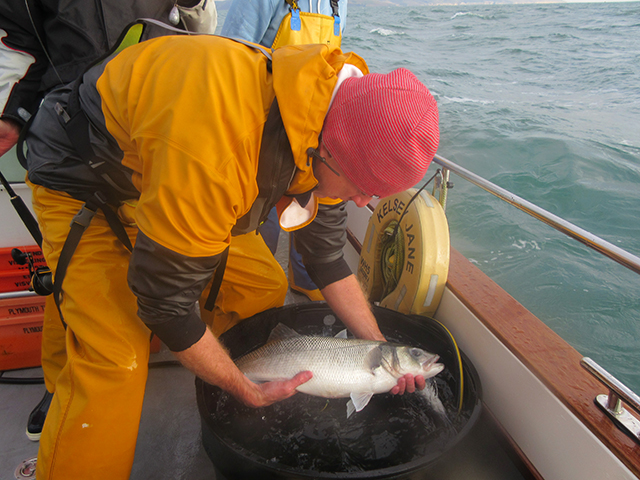
Preparing to return a tagged bass to the sea as part of the four-year CEFAS project.
“One of the fish released at Weymouth also spent time there; it appears to be an aggregation point. We don’t know why yet – they may be feeding there on mobile fish like anchovy, or something like that – we’ll know more when we get more fish and tags back. The more we get back, the more information we will have; it’s all coming together nicely.”
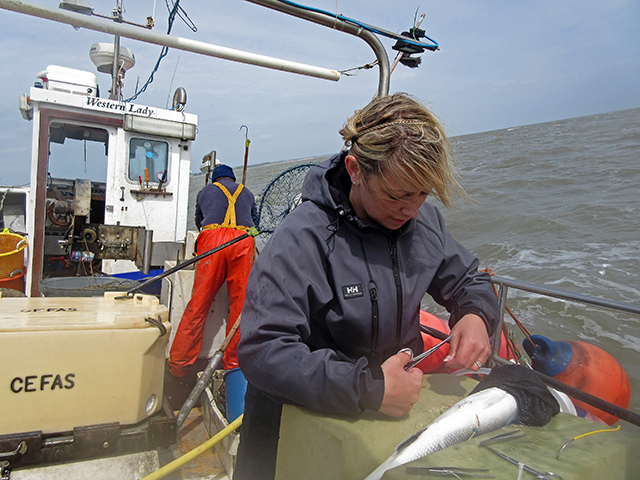
A CEFAS scientist puts a DST tag into a seabass aboard the Western Lady.
In the longer term, the project will be able to look at the relationship between the fishes’ movements and activity in relation to water temperature.
“This is a key thing for bass,” said Dr Hunter. “The nine-degree isotherm is supposed to be the ‘magic number’ for bass to spawn. We’ll be analysing temperature experience and the accompanying activity records in the coming year.”
Vital to return electronic tags – many found on beaches
The CEFAS project is being run over four years and is due to be completed in March 2017. It involves tagging sea bass with electronic data storage tags (DSTs) to learn about their behaviour and migration patterns, rather than the size of the stock. The tags record the depth and temperature experienced by the fish every two minutes.
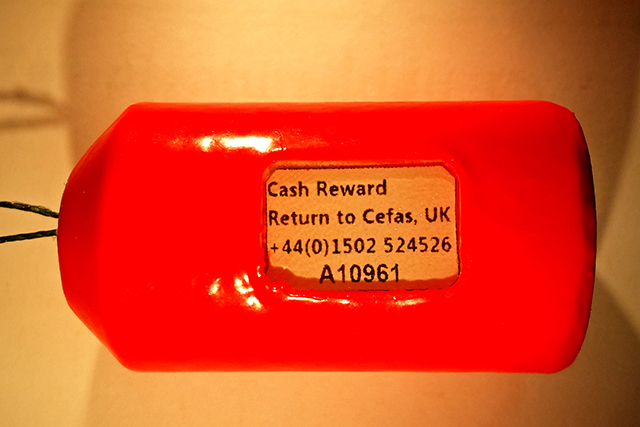
There is a cash reward for returning DST tags.
The DSTs are implanted in the body cavities of the tagged fish. Each DST is encased in a vivid orange ‘floatation jacket’, which allows the tag to float to shore once released from the fish – even when the fish haven’t been caught.
“We want as many people as possible to be involved in this, and for as many tags as possible to be returned – it’s very important we get them back,” said Dr Hunter.
“The tags float if they break free of the fish or are discarded, and many end up on beaches so it’s important for anyone walking on beaches to keep a look out. About a quarter of our tags were found on beaches.”
“We know a lot of people are unhappy with the current bass measures, but we have found fishermen are still engaging with us. We would ask them to remain engaged with the project and return any tags they find, preferably with the fish if possible as well.”
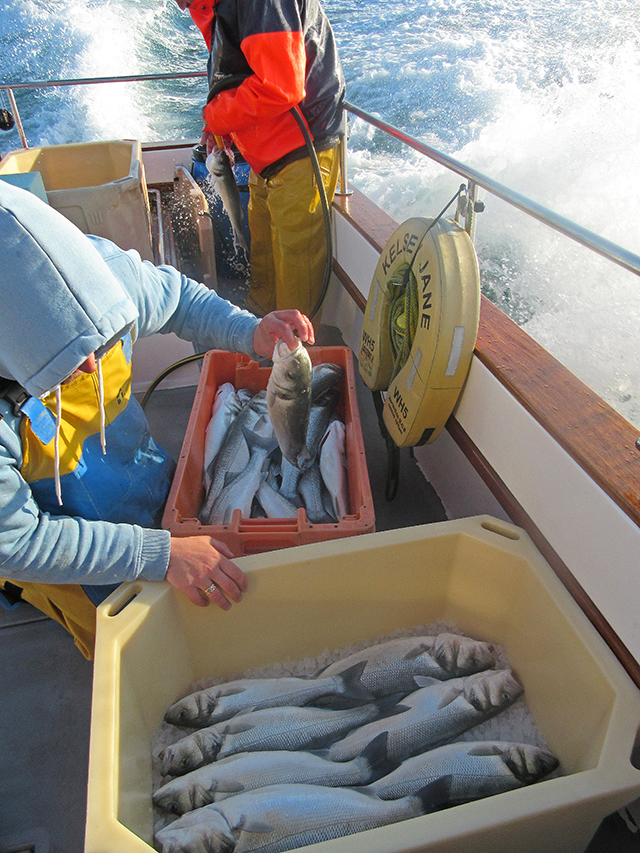 The tags have the address to return them to printed on them and there is a €100 reward for tags returned with the fish as well. The return of the fish is important because the scientists can obtain additional data, for example through the study of their ear bones (otoliths), which can reveal a lot of biological information about their ages and patterns of behaviour.
The tags have the address to return them to printed on them and there is a €100 reward for tags returned with the fish as well. The return of the fish is important because the scientists can obtain additional data, for example through the study of their ear bones (otoliths), which can reveal a lot of biological information about their ages and patterns of behaviour.
Dr Hunter writes a regular blog on the progress of the tagging studies. He says the team likes to get its information out in the public domain as quickly as possible, pointing out that the research is publicly funded. He is encouraging others to add their voices too– “we want to capture a variety of viewpoints on the work,” he said.
Port workshops
CEFAS has been holding workshops in various ports to explain the project and Dr Hunter said they had been ‘inundated’ with requests from fishermen to visit their local areas. Meetings were held in Newlyn and Weymouth last year and another two are lined up for the near future, including one on the east coast.
“It’s great that people want us to visit them and want to get involved in the work, but we have a limited budget. One of my priorities in the coming months will be to look for additional sources of funding.
He said they have a great working relationship with the IFCAs, however further joint-work on bass will depend on future funding.
“For example, the North West IFCA is really interested – the fish we have had returned so far have not migrated north through the Irish Sea and the IFCA thinks there may be another stock/group we are missing,” said Dr Hunter.
A DEFRA-led review of bass spawning areas is also currently underway.
A full report will be produced when the project is completed and there will be publications in scientific journals during the project as well.
‘The French Connection’
CEFAS is working closely with French research body Ifremer on the project.
“The French have had around 160 tags returned but they haven’t looked at any of the tracks yet,” said Dr Hunter. “The combined data from the two studies will greatly move forward what we know about bass population movements. We’re hoping to meet the French scientists in April.”
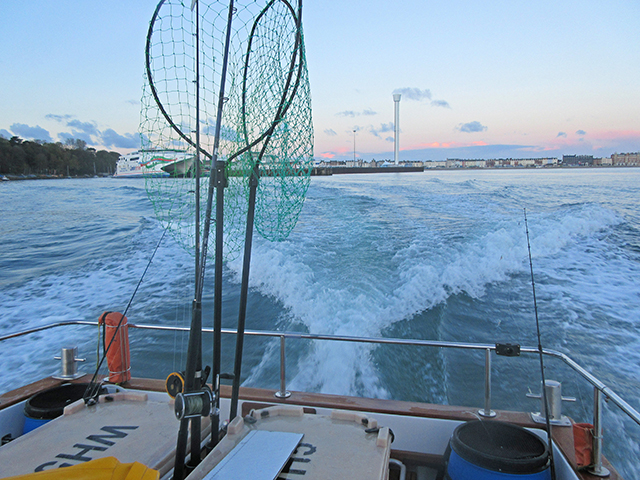
Landing nets ready at hand to ensure bass are safely placed into the live fish storage bins before being tagged.
CEFAS released 48 tagged fish off Weymouth in November 2014 but an original plan to tag a second batch of bass off the Sussex coast last year had to be abandoned because bass failed to appear in the area in the numbers required to make the tagging operation viable. Instead, it was decided to complement the French tagging study by focusing on North Sea bass appearing along the East Anglian coast. Forty-four DST-tagged fish were released off Dunwich in Suffolk from two local vessels, Western Lady and Jolene in May 2015.
“So far we’ve had a fantastic return rate, with six of our Weymouth tags being returned, and our first East Anglian tag coming in just before Christmas!” said Dr Hunter.

The CEFAS tagging study is yielding valuable information on the movement of bass.
“Clearly, the longer our tags remain on fish before being returned, the more valuable they are, because they have more data captured to describe fish movements. However I’m pleased to say that we are already seeing some remarkable results – the scale of movement that we are seeing is even greater than we had previously imagined.”
The longest track so far is a 383-day record from one of the Weymouth bass. The data show that it swam west following release on 4 November 2014, out into the Western Approaches. From February onwards it headed back east and made steady progress up through the Channel, entering the North Sea in early June. At the end of September, the fish abruptly turned NW and flanked Dogger Bank. It then headed south again, and was caught in nets on November 21 2015, off Dungeness (196km from release).
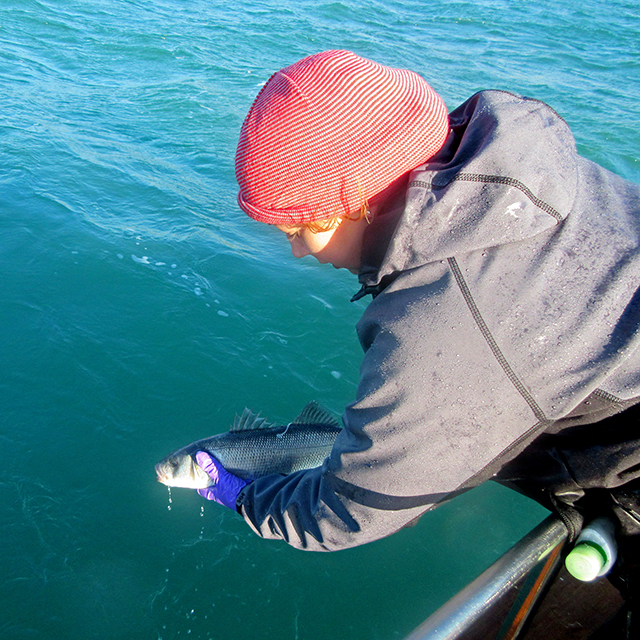
A newly tagged bass is safely returned to the sea.
A second 300-day data record from another Weymouth-released fish show that the bass swam west following release, out into the Western Approaches. It then moved up into the Celtic Sea where it spent January to March. During April to June it swam south, approaching the north coast of Brittany before returning to the Channel. The fish continued on an eastward bearing before it was captured by a UK otter trawler in the Eastern Channel on 30 August 2015.
The CEFAS team is currently reconstructing the movements of all the tag returns.




